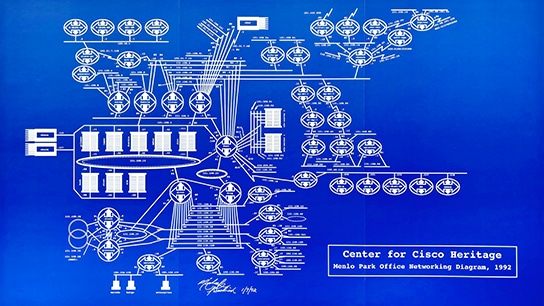

CCNA 2 v7 | CCNA 200-301
- Quality of Content
This is the second of three courses (CCNA 2 Switching, Routing, and Wireless Essentials (SRWE) v7 200-301) that are aligned to the CCNA Certification Exam. SRWE contains 16 modules, each with a series of topics.
Welcome to Switching, Routing, and Wireless Essentials v7.0 (SRWE)
Welcome to the second course of the Cisco Networking Academy CCNAv7 curriculum, Switching, Routing, and Wireless Essentials (SRWE). This is the second of three courses that are aligned to the CCNA Certification Exam. SRWE contains 16 modules, each with a series of topics.
Switching, Routing, and Wireless Essentials advances your knowledge of the operation of routers and switches in small networks. SRWE will introduce you to wireless local area networks (WLANs) and network security concepts.
By the end of this course you will be able to configure advanced functionality in routers and switches. You will also be able to perform basic troubleshooting of these components. Using security best practices, you will troubleshoot and resolve common protocol issues in both IPv4 and IPv6 networks.
The skills and knowledge you gain in SRWE will prepare you for the final course in CCNA. With Cisco Networking Academy, there is no better time than now. Let’s go!

COURSE CONTENT CCNA 2 200-301
Module 1 Basic Device Configuration | CCNA 2 v7
- Module Title : Basic Device Configuration
- Module Objective : Configure devices using security best practices.
Welcome to Basic Device Configuration!
Welcome to the first module in CCNA Switching, Routing, and Wireless Essentials! You know that switches and routers come with some built-in configuration, so why would you need to learn to further configure switches and routers?
Imagine that you purchased a model train set. After you had set it up, you realized that the track was just a simple oval shape and that the train cars only ran clockwise. You might want the track to be a figure eight shape with an overpass. You might want to have two trains that operate independently of each other and are able to move in different directions. How could you make that happen? You would need to reconfigure the track and the controls. It is the same with network devices. As a network administrator you need detailed control of the devices in your network. This means precisely configuring switches and routers so that your network does what you want it to do. This module has many Syntax Checker and Packet Tracer activities to help you develop these skills. Let’s get started!
| Configure initial settings on a Cisco switch. | |
| Configure switch ports to meet network requirements. | |
| Configure secure management access on a switch. | |
| Configure basic settings on a router to route between two directly-connected networks, using CLI. | |
| Verify connectivity between two networks that are directly connected to a router. |
Configure a Switch with Initial Settings
Configure switch ports, secure remote access, basic router configuration, verify directly connected networks, module 2 switching concepts | ccna 2 v7.
- Module Title : Switching Concepts
- Module Objective : Explain how Layer 2 switches forward data.
Welcome to Switching Concepts!
You can connect and configure switches, that’s great! But even a network with the newest technology develops its own problems eventually. If you have to troubleshoot your network, you need to know how switches work. This module gives you the fundamentals of switches and switch operation. Luckily, switch operation is easy to understand!
| Explain how frames are forwarded in a switched network. | |
| Compare a collision domain to a broadcast domain. |
Frame Forwarding
Switching domains, module 3 vlans | ccna 2 v7.
- Module Title : VLANs
- Module Objective : Implement VLANs and trunking in a switched network.
Welcome to VLANs!
Imagine that you are in charge of a very large conference. There are people from all over who share a common interest and some who also have special expertise. Imagine if each expert who wanted to present their information to a smaller audience had to do that in the same large room with all the other experts and their smaller audiences. Nobody would be able to hear anything. You would have to find separate rooms for all the experts and their smaller audiences. The Virtual LAN (VLAN) does something similar in a network. VLANs are created at Layer 2 to reducing or eliminate broadcast traffic. VLANs are how you break up your network into smaller networks, so that the devices and people within a single VLAN are communicating with each other and not having to manage traffic from other networks. The network administrator can organize VLANs by location, who is using them, the type of device, or whatever category is needed. You know you want to learn how to do this, so don’t wait!
| Explain the purpose of VLANs in a switched network | |
| Explain how a switch forwards frames based on VLAN configuration in a multi-switch environment. | |
| Configure a switch port to be assigned to a VLAN based on requirements. | |
| Configure a trunk port on a LAN switch. | |
| Configure Dynamic Trunking Protocol (DTP). |
Overview of VLANs
Vlans in a multi-switched environment, vlan configuration, vlan trunks, dynamic trunking protocol, module 4 inter-vlan routing | ccna 2 v7.
- Module Title : Inter-VLAN Routing
- Module Objective : Troubleshoot inter-VLAN routing on Layer 3 devices.
Welcome to Inter-VLAN Routing!
Now you know how to segment and organize your network into VLANs. Hosts can communicate with other hosts in the same VLAN, and you no longer have hosts sending out broadcast messages to every other device in your network, eating up needed bandwidth. But what if a host in one VLAN needs to communicate with a host in a different VLAN? If you are a network administrator, you know that people will want to communicate with other people outside of your network. This is where inter-VLAN routing can help you. Inter-VLAN routing uses a Layer 3 device such as a router or a Layer 3 switch. Let’s take your VLAN expertise and combine it with your network layer skills and put them to the test!
| Describe options for configuring inter-VLAN routing. | |
| Configure router-on-a-stick inter-VLAN routing. | |
| Configure inter-VLAN routing using Layer 3 switching. | |
| Troubleshoot common inter-VLAN configuration issues. |
Inter-VLAN Routing Operation
Router-on-a-stick inter-vlan routing, inter-vlan routing using layer 3 switches, troubleshoot inter-vlan routing, module 5 stp concepts | ccna 2 v7.
- Module Title : STP Concepts
- Module Objective : Explain how STP enables redundancy in a Layer 2 network.
Welcome to STP Concepts!
A well-designed Layer 2 network will have redundant switches and paths to ensure that if one switch goes down, another path to a different switch is available to forward data. Users of the network would not experience any disruption of service. Redundancy in a hierarchical network design fixes the problem of a single point of failure, yet it can create a different kind of problem called Layer 2 loops.
What is a loop? Imagine that you are at a concert. The singer’s microphone and the amplified loudspeaker can, for a variety of reasons, create a feedback loop. What you hear is an amplified signal from the microphone that comes out of the loudspeaker which is then picked up again by the microphone, amplified further, and passed again through the loudspeaker. The sound quickly becomes very loud, unpleasant, and makes it impossible to hear any actual music. This continues until the connection between the microphone and the loudspeaker is cut.
A Layer 2 loop creates similar chaos in a network. It can happen very quickly and make it impossible to use the network. There are a few common ways that a Layer 2 loop can be created and propagated. Spanning Tree Protocol (STP) is designed specifically to eliminate Layer 2 loops in your network. This module discusses causes of loops and the various types of spanning tree protocols. It includes a video and a Packet Tracer activity to help you understand STP concepts.
| Explain common problems in a redundant, L2 switched network. | |
| Explain how STP operates in a simple switched network. | |
| Explain how Rapid PVST+ operates. |
Purpose of STP
Stp operations, evolution of stp, module 6 etherchannel | ccna 2 v7.
- Module Title : EtherChannel
- Module Objective : Troubleshoot EtherChannel on switched links.
Welcome to EtherChannel!
Your network design includes redundant switches and links. You have some version of STP configured to prevent Layer 2 loops. But now, like most network administrators, you realize that you could use more bandwidth and redundancy in your network. Not to worry, EtherChannel is here to help! EtherChannel aggregates links between devices into bundles. These bundles include redundant links. STP may block one of those links, but it will not block all of them. With EtherChannel your network can have redundancy, loop prevention, and increased bandwidth!
There are two protocols, PAgP and LACP. This module explains them both and also shows you how to configure, verify and troubleshoot them! A Syntax Checker and two Packet Tracer activities help you to better understand these protocols. What are you waiting for?
| Describe EtherChannel technology. | |
| Configure EtherChannel. | |
| Troubleshoot EtherChannel. |
EtherChannel Operation
Configure etherchannel, verify and troubleshoot etherchannel, module 7 dhcpv4 | ccna 2 v7.
- Module Title : DHCPv4
- Module Objective : Implement DHCPv4 to operate across multiple LANs.
Welcome to DHCPv4!
The Dynamic Host Configuration Protocol (DHCP) dynamically assigns IP addresses to devices. DHCPv4 is for an IPv4 network. (Don’t worry, you’ll learn about DHCPv6 in another module.) This means that you, the network administrator, do not have to spend your day configuring IP addresses for every device on your network. In a small home or office, that would not be very difficult, but any large network might have hundreds, or even thousands of devices.
In this module, you will learn how to configure a Cisco IOS router to be a DHCPv4 server. Then you will learn how to configure a Cisco IOS router as a client. This module includes a few Syntax Checkers and a Packet Tracer activity to help you try out your new knowledge. DHCPv4 configuration skills will significantly reduce your workload, and who doesn’t want that?
| Explain how DHCPv4 operates in a small- to medium-sized business network. | |
| Configure a router as a DHCPv4 server. | |
| Configure a router as a DHCPv4 client. |
DHCPv4 Concepts
Configure a cisco ios dhcpv4 server, configure a dhcpv4 client, module 8 slaac and dhcpv6 | ccna 2 v7.
- Module Title : SLAAC and DHCPv6
- Module Objective : Configure dynamic address allocation in IPv6 networks.
Welcome to SLAAC and DHCPv6!
SLAAC and DHCPv6 are dynamic addressing protocols for an IPv6 network. So, a little bit of configuring will make your day as a network administrator lot easier. In this module, you will learn how to use SLAAC to allow hosts to create their own IPv6 global unicast address, as well as configure a Cisco IOS router to be a DHCPv6 server, a DHCPv6 client, or a DHCPv6 relay agent. This module includes a lab where you will configure DHCPv6 on real equipment!
| Explain how an IPv6 host can acquire its IPv6 configuration. | |
| Explain the operation of SLAAC. | |
| Explain the operation of DHCPv6. | |
| Configure a stateful and stateless DHCPv6 server. |
IPv6 Global Unicast Address Assignment
Configure dhcpv6 server, module 9 fhrp concepts | ccna 2 v7.
- Module Title : FHRP Concepts
- Module Objective : Explain how FHRPs provide default gateway services in a redundant network.
Welcome to FHRP Concepts!
Your network is up and running. You’ve conquered Layer 2 redundancy without any Layer 2 loops. All your devices get their addresses dynamically. You are good at network administration! But, wait. One of your routers, the default gateway router in fact, has gone down. None of your hosts can send any messages outside of the immediate network. It’s going to take a while to get this default gateway router operating again. You’ve got a lot of angry people asking you how soon the network will be ‘back up.’
You can avoid this problem easily. First Hop Redundancy Protocols (FHRPs) are the solution you need. This module discusses what FHRP does, and all of the types of FHRPs that are available to you. One of these types is a Cisco-proprietary FHRP called Hot Standby Router Protocol (HSRP). You will learn how HSRP works and then complete a Packet Tracer activity where you will configure and verify HSRP. Don’t wait, get started!
| Explain the purpose and operation of first hop redundancy protocols. | |
| Explain how HSRP operates. |
First Hop Redundancy Protocols
Module 10 lan security concepts | ccna 2 v7.
- Module Title : LAN Security Concepts
- Module Objective : Explain how vulnerabilities compromise LAN security.
Welcome to LAN Security Concepts!
If your career path is in IT, you won’t just be building or maintaining networks. You will be responsible for the security of your network. For today’s network architects and administrators, security is not an afterthought. It is a top priority for them! In fact, many people in IT now work exclusively in the area of network security.
Do you understand what makes a LAN secure? Do you know what threat actors can do to break network security? Do you know what you can do to stop them? This module is your introduction to the world of network security, so don’t wait, click Next!
| Explain how to use endpoint security to mitigate attacks. | |
| Explain how AAA and 802.1X are used to authenticate LAN endpoints and devices. | |
| Identify Layer 2 vulnerabilities. | |
| Explain how a MAC address table attack compromises LAN security. | |
| Explain how LAN attacks compromise LAN security. |
Endpoint Security
Access control, layer 2 security threats, mac address table attack, lan attacks, module 11 switch security configuration | ccna 2 v7.
- Module Title : Switch Security Configuration
- Module Objective : Configure switch security to mitigate LAN attacks.
Welcome to Switch Security Configuration!
An important part of your responsibility as a network professional is to keep the network secure. Most of the time we only think about security attacks coming from outside the network, but threats can come from within the network as well. These threats can range anywhere from an employee innocently adding an Ethernet switch to the corporate network so they can have more ports, to malicious attacks caused by a disgruntled employee. It is your job to keep the network safe and ensuring that business operations continue uncompromised.
How do we keep the network safe and stable? How do we protect it from malicious attacks from within the network? How do we make sure employees are not adding switches, servers and other devices to the network that might compromise network operations?
This module is your introduction to keeping your network secure from within!
| Topic Title | Topic Objective |
|---|---|
| Implement port security to mitigate MAC address table attacks. | |
| Explain how to configure DTP and native VLAN to mitigate VLAN attacks. | |
| Explain how to configure DHCP snooping to mitigate DHCP attacks. | |
| Explain how to configure ARP inspection to mitigate ARP attacks. | |
| Explain how to configure PortFast and BPDU Guard to mitigate STP attacks. |
Implement Port Security
Mitigate vlan attacks, mitigate dhcp attacks, mitigate arp attacks, mitigate stp attacks, module 12 wlan concepts | ccna 2 v7.
- Module Title : WLAN Concepts
- Module Objective : Explain how WLANs enable network connectivity.
Welcome to WLAN Concepts!
Do you use a wireless connection at home, work or school? Ever wonder how it works?
There are many ways to connect wirelessly. Like everything else involving networks, these connection types are best used in particular situations. They require specific devices and are also prone to certain types of attacks. And of course, there are solutions to mitigate these attacks. Want to learn more? The WLAN Concepts module gives you the foundational knowledge you need to understand what Wireless LANs are, what they can do, and how to protect them.
If you are curious, don’t wait, get started today!
| Topic Title | Topic Objective |
|---|---|
| Describe WLAN technology and standards. | |
| Describe the components of a WLAN infrastructure. | |
| Explain how wireless technology enables WLAN operation. | |
| Explain how a WLC uses CAPWAP to manage multiple APs. | |
| Describe channel management in a WLAN. | |
| Describe threats to WLANs. | |
| Describe WLAN security mechanisms. |
Introduction to Wireless
Components of wlans, wlan operation, capwap operation, channel management, wlan threats, secure wlans, module 13 wlan configuration | ccna 2 v7.
- Module Title : WLAN Configuration
- Module Objective : Implement a WLAN using a wireless router and WLC.
Welcome to WLAN Configuration!
Some of us remember getting on the internet using dial up. Dial up involved using your landline phone. Your landline phone was unavailable to make or receive calls while you were on the internet. Your dial up connection to the internet was very slow. It basically meant that, for most people, your computer was always in one place in your home or school.
Then we were able to connect to the internet without using our landlines. But our computers were still hardwired to the devices that connected them to the internet. Today we can connect to the internet using wireless devices that lets us take our phones, laptops, and tablets almost anywhere. It’s nice to have this freedom of movement, but it requires special end and intermediary devices and a good understanding of wireless protocols. Want to know more? Then this is the module for you!
| Topic Title | Topic Objective |
|---|---|
| Configure a WLAN to support a remote site. | |
| Configure a WLC WLAN to use the management interface and WPA2 PSK authentication. | |
| Configure a WLC WLAN to use a VLAN interface, a DHCP server, and WPA2 Enterprise authentication. | |
| Troubleshoot common wireless configuration issues. |
Remote Site WLAN Configuration
Configure a basic wlan on the wlc, configure a wpa2 enterprise wlan on the wlc, troubleshoot wlan issues, module 14 routing concepts | ccna 2 v7.
- Module Title : Routing Concepts
- Module Objective : Explain how routers use information in packets to make forwarding decisions.
Welcome to Routing Concepts!
No matter how effectively you set up your network, something will always stop working correctly, or even stop working completely. This is a simple truth about networking. So, even though you already know quite a bit about routing, you still need to know how your routers actually work. This knowledge is critical if you want to be able to troubleshoot your network. This module goes into detail about the workings of a router. Jump in!
| Explain how routers determine the best path. | |
| Explain how routers forward packets to the destination. | |
| Configure basic settings on a router. | |
| Describe the structure of a routing table. | |
| Compare static and dynamic routing concepts. |
Path Determination
Packet forwarding, basic router configuration review, ip routing table, static and dynamic routing, module 15 ip static routing | ccna 2 v7.
- Module Title : IP Static Routing
- Module Objective : Configure IPv4 and IPv6 static routes.
Welcome to IP Static Routing!
There are so many different ways to dynamically route a packet that you might wonder why anybody would take the time to manually configure a static route. It is kind of like handwashing all of your clothes when you have a perfectly good washing machine. But you know that some clothing items cannot go in the washing machine. Some items benefit from being washed by hand. There is a similarity in networking. As it turns out, there are many situations where a manually configured a static route is your best option.
There are different kinds of static routes, and each is perfect for solving (or avoiding) a specific type of network problem. Many networks use both dynamic and static routing, so network administrators need to know how to configure, verify, and troubleshoot static routes. You are taking this course because you want to become a network administrator, or you want to improve your existing network administrator skills. You will be glad you took this module, because you will use these skills frequently! And because this module is about configuring static routes, there are several Syntax Checker activities, followed by a Packet Tracer and a Lab where you can hone your skills!
| Describe the command syntax for static routes. | |
| Configure IPv4 and IPv6 static routes. | |
| Configure IPv4 and IPv6 default static routes. | |
| Configure a floating static route to provide a backup connection. | |
| Configure IPv4 and IPv6 static host routes that direct traffic to a specific host. |
Static Routes
Configure ip static routes, configure ip default static routes, configure floating static routes, configure static host routes, module 16 troubleshoot static and default routes | ccna 2 v7.
- Module Title : Troubleshoot Static and Default Routes
- Module Objective : Troubleshoot static and default route configurations.
Welcome to Troubleshoot Static and Default Routes!
Well done! You have come to the final module in the Switching, Routing, and Wireless Essentials v7.0 (SRWE) course. This course gave you the in-depth knowledge and skills you need to set up switches and routers (including wireless devices) on your growing network. You really are good at network administration!
But what makes a good network administrator into a great one? The ability to effectively troubleshoot. The best way to gain network troubleshooting skills is simple: always be troubleshooting. In this module, you will troubleshoot both static and default routes. There is a Syntax Checker, a Packet Tracer, and a hands-on Lab where you can hone your troubleshooting skills. Let’s get to it!
| Explain how a router processes packets when a static route is configured. | |
| Troubleshoot common static and default route configuration issues. |
Packet Processing with Static Routes
Troubleshoot ipv4 static and default route configuration.
- Engineering & Technology
- Computer Science
- Computer Networks
Chapter 2 Case Study
Related documents.

Add this document to collection(s)
You can add this document to your study collection(s)
Add this document to saved
You can add this document to your saved list
Suggest us how to improve StudyLib
(For complaints, use another form )
Input it if you want to receive answer
- Skip to main content
- Skip to search
- Skip to footer
Products and Services
Now available: ccna v1.1 exam topics.


CCNA certification
Validate your knowledge and skills in network fundamentals and access, IP connectivity, IP services, security fundamentals, and more. Take your IT career in any direction by earning a Cisco Certified Network Associate (CCNA) certification.
Your career in networking begins with CCNA

CCNA Certification
Take your IT career in any direction by earning a CCNA. CCNA validates a broad range of fundamentals for all IT careers - from networking technologies, to security, to software development - proving you have the skills businesses need to meet market demands.
Networking fundamentals
Showcase your knowledge of networking equipment and configuration. Be able to troubleshoot connectivity issues and effectively manage networks.
IP Services
Demonstrate your ability to configure routing for different IP versions and describe the purpose of redundancy protocols. Be able to interpret the components of a routing table.
Security fundamentals
Understand threats and ways to prevent them. Identify key elements of a security program, like user awareness and training. Demonstrate practical skills like setting up secure access to devices and networks.
Understand how automation affects network management, and compare traditional networks with controller-based networking. Leverage APIs, and understand configuration management tools.
How it works
No formal prerequisites.
CCNA is an asset to IT professionals of all experience levels, but learners often benefit from one or more years of experience implementing and administering Cisco solutions.
Example learner profiles
- Individuals looking to move into the IT field
- IT professionals looking to stand out in the job market
- IT professionals looking to enrich their current roles with additional networking skills

Getting started
To earn this certification, you’ll need to pass a single required exam.
A variety of resources are available to help you study - from guided learning to self-study and a community forum.

Unlock your career potential
Because CCNA covers so many IT fundamentals, it’s a great way to stand out no matter where your career takes you.
Potential roles
Network engineer.
Apply a range of technologies to connect, secure, and automate complex networks.
Network administrator
Install, maintain, monitor, and troubleshoot networks and keep them secure.
Help desk administrator
Diagnose and troubleshoot technical issues for clients and employees.
Alumni testimonials
Ccna moved elvin up the career ladder.

"Passing that CCNA exam triggered a chain of events I could never have predicted. First, I was a student, then a teacher, then a Cisco instructor, and I eventually became a Cisco VIP."
Elvin Arias Soto, CloudOps engineer
CCNA, CCDP, CCDA, CCNP, CCIE
Certifications give Kevin instant credibility at work

"People always want to know who they're talking to. They want to know if you’re qualified. Certifications give you instant credibility."
Kevin Brown, CyberOps analyst
CCNA, CyberOps Associate
Ben made a career change with a Cisco certification

"I chose to pursue Cisco certifications because I knew it would put me in the best position to start a career in networking."
Ben Harting, Configuration engineer
Maintain your certification
Your certification is valid for three years. You can renew with Continuing Education credits or retake exams before they expire.
CCNA essentials webinar series
Learn what to expect from the CCNA exam, and chart your path to certification success.
CCNA certification guide
Get familiar with Cisco’s learning environment, find study resources, and discover helpful hints for earning your CCNA.
CCNA Prep Program
Packed with 50+ hours of resources, webinars, and practice quizzes, CCNA Prep On Demand is your ultimate study buddy.
Enhance your learning journey
Stay up to date.
Get the latest news about Cisco certifications, plus tools and insights to help you get where you want to go.
CCNA community
Not sure where to begin? Head to the Cisco CCNA community to get advice and connect with experts.
CCNA 2: Routing & Switching Essentials v5.0.3+v6.0 Exam Answers
Ccna 2 v6.0: routing and switching essentials.

- Implement DHCP on a router.
- Implement network address translation (NAT).
- Implement access control lists (ACLs) to filter traffic.
- Determine how a router will forward traffic based on the contents of a routing table.
- Implement static routing.
- Explain how switching operates in a small to medium-sized business network.
- Configure Ethernet switch ports.
- Implement VLANs.
- Use monitoring tools and network management protocols to troubleshoot data networks.
- Configure monitoring tools available for small to medium-sized business networks.
- Configure initial settings on a network device.
| CCNA 2 – Routing and Switching Essentials (Version 6.0) Exam Answers | Online Test |
|---|---|
| Chapter 6 Practice Skills Assessment PT Answers | |
| CCNA 2 – RSE (Version 5.0) Chapter 11 Exam Answers | |
IMAGES
VIDEO
COMMENTS
Download pka file: https://drive.google.com/file/d/1Y01pwp1tmOXfTBBtlsdP0HGe__X7S87F/view?usp=sharingPlaylist: https://www.youtube.com/playlist?list=PLdtRZtG...
CCNA 2 v7.0 - The second course in the CCNA curriculum focuses on switching technologies and router operations that support small-to-medium business networks and includes wireless local area networks (WLAN) and security concepts. Students learn key switching and routing concepts. They can perform basic network configuration and troubleshooting, identify and mitigate LAN security threats, and ...
Learn the basics of switching, routing, and wireless networks with this CCNA course playlist. Watch complementary videos and prepare for the final exam.
This case study involves designing, implementing, and documenting a network for a company. The tasks include: 1. Designing the network topology using a provided diagram. 2. Implementing IP addressing schemes and assigning addresses. 3. Configuring routers, switches, and workstations with basic settings. 4. Adding access control lists (ACLs) to routers to restrict access and enable security. 5 ...
CCNA2 case study 2022 - Free download as PDF File (.pdf), Text File (.txt) or read online for free. The document outlines an 8 phase case study for students to design and configure a complex network for Rockford PLC, a manufacturing company. Key requirements include: 1. Designing the network topology and addressing scheme connecting 3 locations using leased lines and VLANs.
CCNA 2: Case Study. Design and document an addressing scheme based on requirements. Apply a basic configuration to the devices. Disable routing updates on appropriate interfaces. Verify full connectivity between all devices in the topology. NOTE: Interface Fa0/0 has been preconfigured on R1, R2, R3, and R4. Task 2: Apply a basic configuration.
Routers and Routing Basics CCNA 2 Lab Study Guide is a supplement to your classroom and laboratory experience with the Cisco Networking Academy Program. Specifically, this book covers the second of four courses. To be successful on the exam and achieve your CCNA certification, you should do everything possible to arm yourself with a variety of ...
Cisco Public Page 1 of 8 www.netacad.com Case Study CCNA 2 - Switching, Routing and Wireless Essentials Topology Assessment Objectives Part 1: Initialize, Reload and Configure Basic Device Settings Part 2: Configure Network Infrastructure Settings (VLANs, Trunking, Etherchannel) Part 3: Configure Host Support Part 4: Test and Verify IPv4 and ...
CCNA 2 v7 Switching Routing and Wireless Essentials-Version-Final-Answers-23. Packets that are received from the Internet will be forwarded to one of the LANs connected to R1 or R2. Packets with a destination network that is not 10.10../16 or is not 10.20../16 or is not a directly connected network will be forwarded to the Internet.
Download File: https://drive.google.com/file/d/0B18E05jPriDHU1RNNGwydUtTbU0/view?usp=sharing
CCNA 2 v7 Switching, Routing, and Wireless Essentials (Version 7.00) - SRWE Practice Skills Assessment - PT Part 2 Exam Answers Packet Tracer file .pka download ... links between routers for most data traffic and reserve serial link between R-1-A and R-B-10 for backup purposes in case one of the Ethernet links becomes unavailable. You will be ...
CCNA-2v7. Case Study (rev A) - Static Routes, VLANs, Switch Security, DHCP, Wireless, Spanning-Tree PHASE II - Router Configuration The following table outlines the configuration tasks you need to perform on the routers and Layer-3 switch In the topology. Where specific configurations are required, they are noted below; otherwise it is your discretion which names, descriptions, banners, and ...
Tests. Exams. 5. Summary. This is the second of three courses (CCNA 2 Switching, Routing, and Wireless Essentials (SRWE) v7 200-301) that are aligned to the CCNA Certification Exam. SRWE contains 16 modules, each with a series of topics. Welcome to Switching, Routing, and Wireless Essentials v7.0 (SRWE)
CCNA Discovery: Introducing Routing and Switching in the Enterprise Chapter 2 Case Study. Step 4: Verify configuration of the switch Verify that the IP address of the management interface on the switch VLAN 1 and the IP address of PC1 are on the same local network. Use the show running‐config command to check the IP address configuration of ...
CCNA: Routing and Switching Essentials Case Study Part 2: Configure Switch Security, VLANS, and Inter VLAN Routing Step 1: Configure S1. Configuration tasks for S1 include the following: Configuration Item or Task Specification Create the VLAN database Use Topology VLAN Key table to create and name each of the listed VLANS. Assign the management IP address.
However, Cisco Packet Tracer has some significant advantages for CCNAs: · Cost: Free. · Low CPU & RAM: It should run on the computer you already own as a desktop app. · Usefulness for CCNA: Supports 90%+ of the CCNA config/verify topics. · Quality: Excellent for its intended purpose as a learning tool.
Scribd is the world's largest social reading and publishing site.
To earn your CCNA certification, you must pass the 200-301 CCNA exam. This 120-minute exam tests your knowledge of: Network Fundamentals. Network Access. IP Connectivity. IP Services. Security Fundamentals. Automation and Programmability. Expand each item below to view related exam topics.
In this Skills Assessment (SA) you will configure the devices in a small network. You must configure a router, switch and PCs to support IPv4 connectivity for supported hosts. Your router and switch must also be managed securely. You will configure Single-Area OSPFv2, NAT, and access control lists.
Your career in networking begins with CCNA. CCNA Certification. Take your IT career in any direction by earning a CCNA. CCNA validates a broad range of fundamentals for all IT careers - from networking technologies, to security, to software development - proving you have the skills businesses need to meet market demands.
Study with Quizlet and memorize flashcards containing terms like PDU, Frame, Layer 2 Switch and more. ... CCNA. 66 terms. ander_castellano003. Preview. Port Numbers. Teacher 19 terms. Josh_Slocum65. Preview. Microsoft study set. 61 terms. Kyra_Quinn. Preview. outlook notes for computer test. 8 terms. addisonmorgan187.
Use monitoring tools and network management protocols to troubleshoot data networks. Configure monitoring tools available for small to medium-sized business networks. Configure initial settings on a network device. CCNA 2 - Routing and Switching Essentials (Version 6.0) Exam Answers. Online Test.
Asked by zona19w. Image transcription text. CCNA-2 Case Study -VLANS, NAT, IPV4, IPV6, Router & Switch Configuration. PHASE II - Router Configuration The following table outlines the configuration tasks. you need to perform on the routers in the topology.